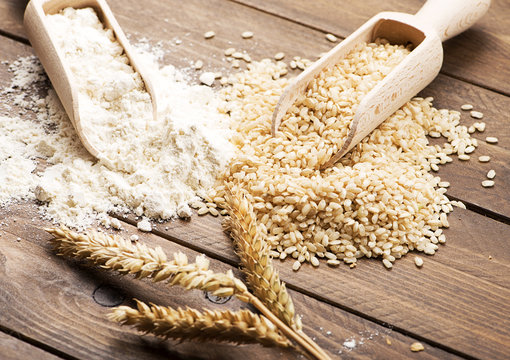When it comes to food, wheat and rice are the two most commonly consumed grains in the world. In India, they are an integral part of our meals, whether it's breakfast, lunch, or dinner. From the north to the south, each region has its preference – wheat, often enjoyed as roti (flatbread), and rice, a favorite staple in many households. But the age-old debate continues: Which is better for health – wheat or rice?
Let’s dive into the nutritional values of both and explore which one might be better for your health.
Nutritional Breakdown: Wheat vs. Rice
To understand the differences, let’s compare the nutritional value of 100 grams of whole wheat flour (the unprocessed wheat we buy and mill without sieving) and 100 grams of raw white rice.
Calories and Carbs
- Rice: 350 calories, 78-80 grams of carbohydrates.
- Wheat: 340 calories, 70-72 grams of carbohydrates.
While the calorie content is quite similar, rice has a slightly higher carb content. Both grains are excellent sources of energy, but wheat has a slight edge in terms of fiber and protein.
Protein and Fiber
- Wheat: 12 grams of protein, 12 grams of fiber.
- Rice: 8 grams of protein, minimal fiber.
Wheat shines in this category, with a higher protein and fiber content. The fiber in wheat helps with digestion and keeps you feeling full for longer. This makes wheat a better option for those looking to manage their hunger and maintain a stable blood sugar level.
Fat Content
- Wheat: 1.7 grams of fat.
- Rice: 0.5 grams of fat.
Both grains are low in fat, but wheat has a bit more. However, the difference is negligible when considering the overall health impact.
Vitamins and Minerals
- Wheat: Rich in calcium, iron, magnesium, phosphorus, potassium, zinc, and sodium.
- Rice: Contains minerals but in lesser quantities, and it has very little sodium.
Wheat provides a broader range of minerals and essential B-complex vitamins. While rice also contains some minerals, wheat offers a more balanced nutritional profile.
So, Which Is Better for Health?
Based on the nutritional breakdown, wheat (especially whole wheat) appears to have the upper hand due to its higher protein and fiber content. The fiber helps to maintain healthy digestion and regulate blood sugar, which is particularly beneficial for those at risk of diabetes. Additionally, wheat has a lower glycemic index compared to rice, meaning it won’t spike your blood sugar levels as rapidly.
But does this mean you should ditch rice entirely? Absolutely not!
The Role of Rice in a Balanced Diet
While rice has more simple carbs, which can raise blood sugar levels faster than wheat, it is still an important staple in many cultures. The key is in how rice is consumed. Typically, rice is paired with lentils (dal), vegetables, and salads. This combination significantly boosts its nutritional value by adding fiber and protein, making it a more balanced meal.
Similarly, wheat-based meals like roti can be paired with vegetables, dals, and a source of protein, such as meat, eggs, or fish, to enhance their nutritional profile.
Also Read:
Moderation Is Key
The truth is, both wheat and rice have their place in a healthy diet. The choice between the two often depends on cultural preferences and regional availability. The key is to enjoy both in moderation and balance the portions according to your activity level.
- For those with a sedentary lifestyle, it’s crucial to limit portion sizes to avoid weight gain and blood sugar spikes.
- Athletes or those who engage in regular physical activity may need larger portions to meet their energy requirements.
For People with Diabetes
If you have diabetes, it’s essential to limit your rice intake. Rice can be consumed in moderation, but it’s crucial to pair it with protein-rich foods like dal, vegetables, and salads to improve its nutritional profile and reduce blood sugar spikes.
कढ़ी पत्ता (Curry Leaves) – आपकी रसोई में छुपा सुपरफूड | फायदे, उपयोग, पोषण और सावधानियां
Conclusion: Wheat or Rice?
In the end, there’s no one-size-fits-all answer. Whether you prefer roti (wheat) or rice, both can be part of a healthy diet if consumed thoughtfully. The key is to choose what works best for your body and pair it with other nutritious foods.
If you’re still unsure about which one to choose, remember: it’s not about choosing one over the other, but about making balanced, healthy choices based on your individual needs.
If you found this information helpful, don’t forget to like, share, and pass it along to your friends and family. Let them know that both wheat and rice are good for your health as long as you make mindful, informed decisions about your diet.


.png)









